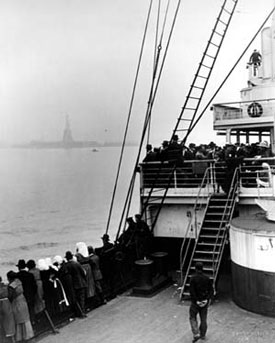|
Back
to Voices
Emma
Lazarus and Her Vision by Bette Roth Young
 |
The New Colossus
Not like the brazen giant
of Greek fame,
With conquering limbs astride from land to land;
Here at our sea-washed sunset gates shall stand
A mighty woman with a torch, whose flame
Is the imprisoned lightning, and her name
Mother of Exiles. From her beacon-hand
Glows world-wide welcome; her mild eyes command
The air-bridged harbour that twin cities frame.
"Keep ancient lands,
your storied pomp!" cries she
With silent lips. "Give me your tired, your poor,
Your huddled masses yearning to breathe free,
The wretched refuse of your teeming shore,
Send these, the homeless, tempest-tost to me,
I lift my lamp beside the golden door."
|
|
|
|
For almost one hundred
years, the Statue of Liberty has welcomed immigrants from around
the world. But when she was installed on Bedloe's island in
New York harbor, that had not been her purpose. The citizens
of France gave the statue to the citizens of the United States
in commemoration of both countries' commitment to "Liberty."
Emma Lazarus, New York born and bred, had other ideas. Naming
her "Mother of Exiles," Lazarus wrote her poem to
that majestic lady in validation of the thousands of immigrants
streaming through our "golden door." The Statue of
Liberty would welcome the "wretched refuse," the rejects
of European society, to a country which would transform them
into the dynamic, creative, productive, inventive American citizens
they would become. This was Emma's vision, a vision that would
be fulfilled.
Emma Lazarus was
rooted deeply in American soil. Her ancestors had come here
as immigrants since before the American Revolution. They would
establish and participate in the small but growing Jewish community.
By the time Emma came along, members of her family were prosperous
and well-regarded in Manhattan where they lived. Emma was raised
in the lap of luxury but even as a child she exhibited a talent
for poetry as well as a sensitivity and perceptiveness beyond
her years. She was vitally interested in her family, her city,
and her people.
In the early 1880's, Emma became
aware of the harsh discrimination against Jews who lived in Eastern
Europe, especially those under the rule of Russia's newest czar.
Fortunately, many of these outcasts were able to make the long
and arduous trek. walking across Europe to sail in steerage, in
unimaginably harsh circumstances, for weeks across the unpredictable
Atlantic Ocean, to the "golden medina, the United States
where the streets were said to have been paved with gold. In reality,
they found life on the Lower East Side of New York as inhospitable
in its own way as had been the shtetls from which they fled. These
"huddled masses" became a topic for discussion and concern
for Manhattan's elite. Soon, Emma Lazarus participated in the
conversation.
She was so taken with what she
would see, read and hear that she began to volunteer in institutions
set up for helping these new "greenhorns," teaching
them to read and learn English.
She became their spokesperson,
they became her crusade. Already known as a woman of immense intelligence,
Emma published articles in the leading journals and newspapers,
Jewish and general. She studied Hebrew and Yiddish and steeped
herself in Jewish history and culture. When she was asked to write
a sonnet to the statue, she refused at first. But when it was
suggested that she write about her in the context of her beloved
Jewish immigrants, she agreed to try. Three days later, she had
finished "The New Colossus."
It was not at all certain that
we would read her words. After the poem was written in 1883, it
was largely forgotten until Emma's friend, Georgina Schuyler,
rescued it from oblivion. She called upon Richard Watson Gilder,
Emma's editor and friend, to help her immortalize "The New
Colossus" by engraving it upon a bronze plaque to be placed
in the pedestal of the Statue. It took two years of red tape,
but in the end, because of the persistence of Schuyler and Gilder,
the plaque found its place within the pedestal of the statue that
Emma's sonnet had redefined. Her vision of this country as a refuge
with the capacity for regeneration of the human spirit has endured,
notwithstanding sporadic periods of harsh immigration restrictions.
Emma, her statue, and her immigrants are indivisible. "The
New Colossus" is one of the best known and most often quoted
documents in our American experience.
More
about Emma Lazarus:
Jewish
Women's Archive
http://www.jwa.org/exhibits/lazarus/

To see the original copy book page containing Emma Lazarus'
poem, The New Colossus inscribed on the Statue of Liberty:
http://www.jwa.org/exhibits/lazarus/el9.htm
|
